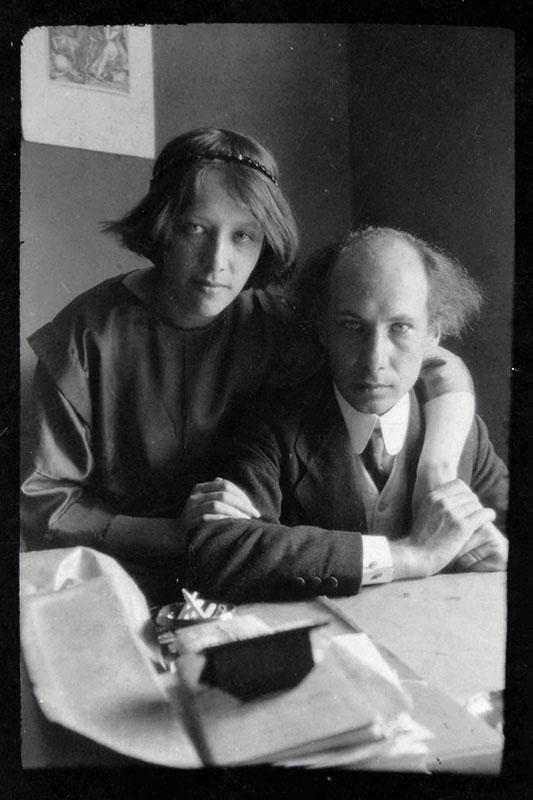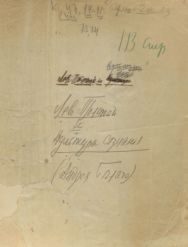Andrey Belyi – Mediterranean traveller (new materials)

In 1910–1911 Andrey Belyi undertook an almost half-year long trip abroad: he left Moscow on November 26 / December 9, 1910, and returned to Russia (Odessa) on April 22 / May 5, 1911. He travelled with A. A. Turgeneva, who he had decided to be with right before the departure (the official marriage took place in March 1914 in Bern). The original plan was to travel through Austria and Italy to Sicily, where they would spend winter (Belyi was planning to start working on the second part of his novel “Serebrianyi golub’” – the future “Peterburg”), and then set off back and get acquainted with Italy in more detail on their way. Belyi recollected this plan describing the departure from Moscow: “Ulybalis’ my, stranniki: stranstvie mesiatsy zrelo, pognav iz Moskvy mimo pyshnykh muzeev v Sitsiliiu, chtoby s nachalom vesny nam podniat’sia na Sever: obzorom Italii; tak my khoteli”[1]. The original plan was for Belyi and A. A. Turgeneva to have a quick glimpse of Venice (December 12, old style), Rome, Naples (the fleeting impressions were enough for Belyi to compile a number of travel notes[2]) and arrive in Sicily, Palermo, on December 17. A weak later they were in Montreal, a city 5 km away from Palermo, with its famous 12th-century cathedral. Sicily impressed Belyi with its cultural monuments characterized by multi-layer intersection of Western European, Byzantine and Eastern elements. The interest to the East – the unknown Arabic East – was so strong that instead of a long-term stay in Sicily (hindered by lack of amenities as well) and later journey across Italy the travellers set off to the African shore – to Tunisia (January 5, 1911), where they stayed for more than two months in the Arabic village Rades near the city of Tunis. On March 8 Belyi and A. Turgeneva set sail from Tunisia to Egypt, where they spent almost a month, on April 10 they arrived in Jerusalem and two weeks later departed across the Aegean Sea to Russia via Constantinople.
The time spent in this trip turned out to be one of the brightest, most pleasant and peaceful periods of Belyi’s life. The travel notes he was writing in Sicily and Africa formed a book, which remained unpublished for a long time for a number of reasons (separate fragments appeared in periodicals[3]) and finally appeared in the revised version in 1919. Its first volume was printed twice when Belyi was alive[4], but the second volume had remained unknown until recently[5].
[1] Belyi Andrei. Putevye zametki. T. 1. Sitsiliia i Tunis. M.; Berlin: Gelikon, 1922. P. 15.
[2] They were being published under the common title “Putevye zametki” in the Saint Petersburg newspaper “Rech’” in 1911 (“Venetsiia” – January 25, “Ot Venetsii do Palermo” – February 2, “Palermo” – February 13, “Pestryi sfinks” – June 5, “Smekh i slezy” – July 3, “Raduga Monrealia” – July 24).
[3] The text “Tunis” was printed in “Rech’” on September 29, 1911, and in the newspaper “Sovremennoe slovo” on the same day, the text “Araby (Iz pisem s dorogi)” appeared in the newspaper “Utro Rossii” on April 5, 1911, “Egipet” in the magazine “Sovremennik” (1912, № 5–7), “Dervish (Iz putevykh zametok)” in the book: Veles. 1-i al’manakh russkikh i inoslavianskikh pisatelei. Pg., 1912–1913. P. 85–103.
[4] See: Belyi Andrei. Ofeira. Putevye zametki, ch. I. M.: Knigoizdatel’stvo pisatelei v Moskve, 1921; Belyi Andrei. Putevye zametki. T. 1. Sitsiliia i Tunis. M.; Berlin: Gelikon, 1922.
[5] Published by S. Voronin (““Afrikanskii dnevnik” Andreia Belogo”) with an introduction by N. Kotrelev (“Zloschastnaia sud’ba schastlivoi knigi. K istorii putevykh zapisok Andreia Belogo”) in: Rossiiskii arkhiv. Istoriia Otechestva v svidetel’stvakh i dokumentakh XVIII–XX vv. <Pt.> I. M., 1991. P. 327–454.

























